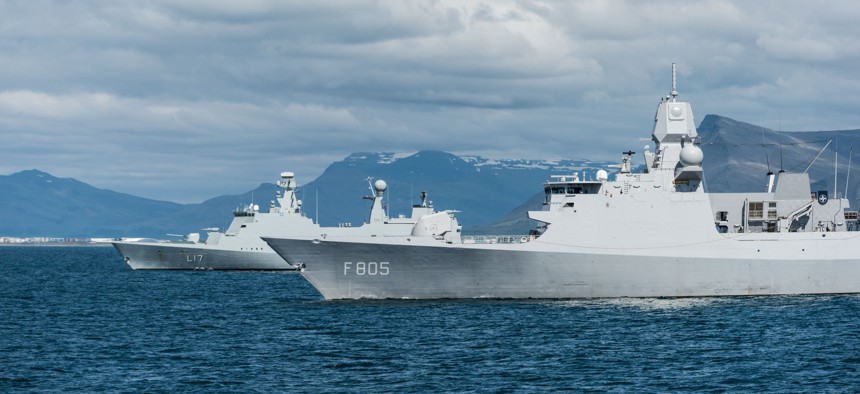
NATO forces sail off Reykjavik during the 2017 Dynamic Mongoose exercise. NATO / FRAN CPO Christian Valverde
NATO Needs to Step Up its Maritime Defenses
Here are a few steps the alliance should pursue at its upcoming summit in Brussels.
Just one day after President Trump told the presidents of Latvia, Lithuania, and Estonia that he was “proud to reaffirm America’s commitment” to the sovereignty of the three Baltic nations, Russia underscored the proximity of its military might to these U.S. allies with live-fire missile tests in the Baltic Sea.
Held within the exclusive economic zone of Latvia, the tests were only the latest in a long series of Russian actions that highlight the importance of an effective Western deterrent. Alliance efforts to improve ground forces have generally taken center stage in this dynamic, but Russia’s advancing technology and bold tactics are also playing out in and around the maritime domain, including in the littoral environments of the Baltic and Norwegian Sea regions. With the 2018 NATO Summit in Brussels approaching, the Alliance should bring long-overdue focus to the maritime challenges in Northern Europe—and the steps it must take to address them.
In recent years, Russian shallow-water naval capabilities in Northern Europe have improved substantially, and now present the greatest challenge to NATO’s fleets since the end of the Cold War. Russia’s diesel-electric Kilo-class and nuclear-powered Akula- and Yasen-class submarines can remain quietly submerged for extended periods of time, making their movements extremely difficult to detect—particularly in the Norwegian Sea. (This problem is exacerbated by the aging and depletion of NATO’s stockpile of sonobuoys, a key subhunting tool.) Such submarines are newly capable of long-range precision strike, thanks to the 3M14 KALIBR naval land attack cruise missile, which has been fired against targets in Syria from warships and subs in the Mediterranean and Caspian Seas. The addition of the KALIBR missiles to Russia’s Baltic Fleet allows Russian vessels to strike large swaths of Western Europe through Swedish, Finnish, and Norwegian airspace. Combined with the Russian Air Force presence in Kaliningrad and the nearby Kola Peninsula, as well as advanced amphibious forces and light infantry that easily navigate the unique geography of northern Europe, Russian ships and subs bring a formidable array of capabilities.
Countering the full spectrum of Russian threats requires a well-developed understanding of the entire maritime domain, which involves land, sea, and air components. NATO suffers deficiencies in its ability to assess and respond in each of these domains as well as its ability to counter the multidimensional risks across them. Information-sharing is hampered by the fact that Sweden and Finland are NATO partners but not members, and by various barriers between the commercial shipping industry, civilian law enforcement, and military entities.
A tractable NATO Summit initiative to improve maritime awareness and response in the close-in littoral regions of Europe would have three components.
First, NATO should commit to improving its anti-submarine warfare capabilities to counter the subsurface threats posed by Russia. One way to do this is an apparatus like the ASW Operations Centers that NATO used during the Cold War to consolidate and improve its defenses against submarines. Another is to develop and buy newer and more advanced sonobuoys.
Second, with the advent of Russia’s long-range precision strike capabilities, NATO must be capable of monitoring a wide range of prospective launch platforms above, on, and below the surface of the seas. The alliance should upgrade air surveillance and defense capabilities, with a new focus on forward activities to monitor undersea launch sites.
Third, NATO should commit to improving information-sharing and security arrangements with partners in the region. Information about Russian activity and aggression must freely flow between Alliance members and partners, as the threat to northern Europe involves the land, sea, and air. Agreements like the Sea Surveillance Co-Operation Baltic Sea (SUCBAS) agreement have proven effective in the past and could be built upon to construct a comprehensive multinational understanding of the environment.
In the restricted geography of the Baltic and Norwegian Sea regions, Russian actions concern both Allies and NATO partners as well as military and civilian entities. The Alliance must have both a framework that incorporates these friendly actors and credible capability to deter and defeat from land, air, and sea. The United States is uniquely positioned to lead NATO and its partners in these efforts. Its blue and brown water naval capability is unparalleled, and its influence with all western nations in the region is significant. The United States should exercise its leadership potential to drive these key changes in NATO information sharing arrangements and federated alliance and partner investments to counter the Russian challenges in Northern Europe’s maritime environs.
This article corresponds with the release of a full-length CSIS report, Contested Seas: Maritime Domain Awareness in Northern Europe, released in March 2018.



